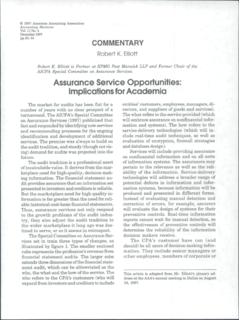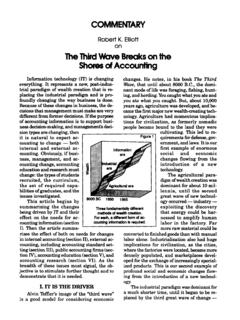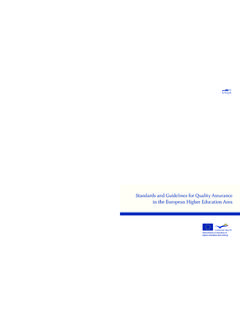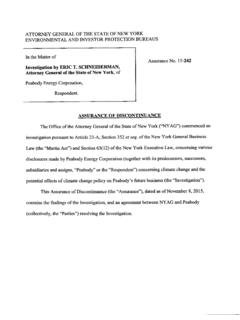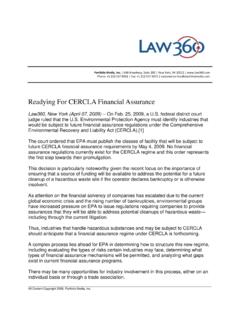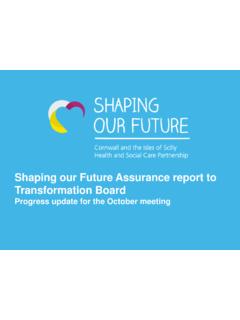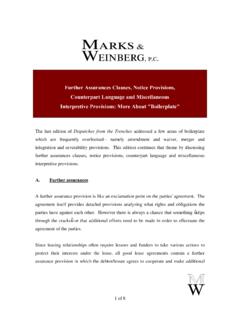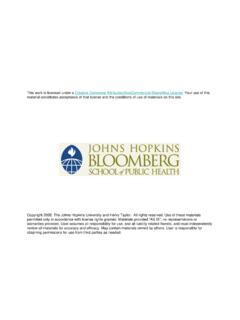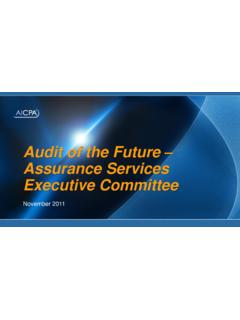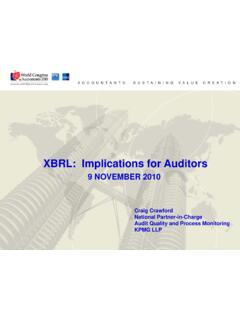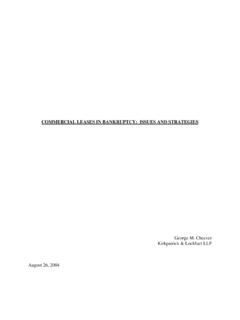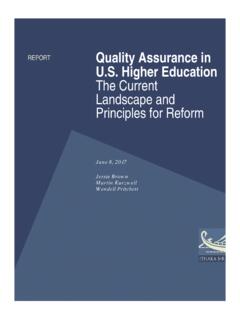Transcription of Robert K. Elliott is Chairman, KPMG Peat Marwick LLP ...
1 1995 American Accounting AssociationAccounting HorizonsVol 9 No. 4 December K. ElliottRobert K. Elliott is chairman , kpmg Peat Marwick LLP, AICPA Special Committee onAssurance future of assurance Services:Implications for AcademiaThe AICPA Special Committee on Assur-ance Services was set up in response to a de-cline in the market vitality of the audit. (SeeElliott 1994a and 1994b for background.) Ourpurpose is to develop ideas and initiate stepsto refurbish the profession's product. This mis-sion was conceived in response to the currentand emergent audit/ assurance environment,the obvious context for considering the vital-ity of the current audit is surely very valuableto the capital markets and to our economy, butit is a mature product that has not been grow-ing. Over the last six years real accountingand auditing revenues for the top 60 firmshave been flat despite growing GDP.^ The mar-ket seems saturated; there is overcapacity andprice competition; and the inherent reliabil-ity of accounting data has increased with im-provements in business information audit service is generalized a one-size-fits-all product rather than tailored to theindividual needs of investors and creditors andother users, yet responding to individual cus-tomer needs is one of the great messages ofthe last decade of economic change.
2 Mean-while, software that can do audit functions isa long-term threat. Imagine banks purchas-ing or developing such software and auditingtheir own debtors, institutional investors au-diting investees, or internal auditing bolsteredby advanced software that drastically reducesthe evidence needed for an audit large part of the immediate problem isthe limited usefulness of today's financialstatements. They don't, for example, reflect in-formation-age assets, such as information, ca-pacity for innovation, and human a consequence, they have been a decliningproportion of the information inputs to inves-tors' decision making. That translates into adeclining share of the information market-place for auditors (and, for that matter, finan-cial accountants). Were financial statementsas central to investors' decision making asthey were thirty years ago, there would berelatively little concern over the vitality of , the Committee was not intendedto address improvements in financial report-ing.
3 That was the job of the Special Commit-tee on Financial Reporting (the Jenkins Com-mittee), which completed its work last recommendations have not yet been en-acted, but it would nevertheless have beensuperfluous to appoint an additional commit-tee devoted to refurbishing financial task is to refurbish the profession's"product" in a different sense: to identify newservices in the wider area of the assurancefunction, an area that includes the basic au-dit, but goes beyond it. This must take place' Derived from data published in Accounting article is adapted from Mr. Elliott 's plenary addressat the AAA's annual meeting in Orlando on August 16, future of assurance Services: Implications for Academia119with an eye to the future , for the committee ischarged to take a long-term SCOPE OFASSURANCE SERVICESWhat heyond the audit might the Commit-tee recommend? The full potential scope is il-lustrated in figure Scope of assurance ServicesRaw Refinedinformation informationDecisionmakerUtilityfunctionF igure 1 This figure depicts a decision maker withresources to allocate, a utility function (his orher own, in the case of personal decisions; theentity's, in the case of entity decisions), a hrain(incorporating knowledge and experience), andinformation.
4 Decisions ( , to invest in a prod-uct) result in outcomes ( , a profit or loss).The four gray arrows represent possiblescopes for assurance services. In the case ofarrow 1, raw information is refined into reli-ahle information. This scope of assurance goesno further than the current attestation stan-dards. Note that it is also independent of thedecision maker. Any raw information can berefined, regardless of whether it is used fordecision making at 2 represents services that improvedecision making, including those that enhancenot only the reliability of information, but alsoits relevance and availability for the 3 represents services that improvedecisions, including those that improve thedecision maker's store of knowledge (beyondthe decision information itself), decision mod-els, and decision processes. For example, anassurer might assist the decision maker inframing the decision problem, modeling thedecision process, identifying the informationrequirements, sourcing the information,evaluating the information, monitoring out-comes, and providing feedback to the decisionmaker and information 4 represents services that improveoutcomes.
5 Such services resemble insurancemore than assurance , 2 shows the relationship of audit,attestation, and assurance services. Attesta-tion includes traditional audits of financialstatements, but also such other products asreviews and agreed-upon procedures. Theseservices do not exhaust the attestation space,however. assurance includes attestation, butgoes beyond. The figure shows some candidateservices (yet to be specified), but includesmuch more space for the development of fu-ture assurance ServicesFigure 2 THE COMMITTEE'S APPROACHThe Committee's primary method for iden-tifying potential services, however, has beenmuch more inductive. It has been based onresearching customer needs. In-depth inter-views have been the major research methodapplied so far. We have interviewed institu-tional investors, investment analysts, credi-tors, suppliers, managers in industry (in-cluding members of senior management),members of corporate boards, governmentregulators, and state and local governmentalofficials.
6 The purpose of the interviews was,first, to determine interviewees' needs whenthey perform decision making. We found thatcustomers for current attest services, for ex-ample, have quite a variety of unfilled needsin using information for decision making. You120 Accounting Horizons /Decemberl995can get a fuller picture of this approach fromthe matrix in figure 3, which has potentialcustomer types and decision types as its twoaxes. The gray cells appear to be high poten-tial cells (sufficient volume and significanceto warrant potential assurance services).Customer NeedsDecisio. oS o ^-E g a. EVi ^ B ^<u to CO c> ,E i= o- ii_ CO oInstitutional investors ^^^^H|~Analysts ^^^^H~ Individual investors ^^^^H~J: Creditors ^^^^^~^ Suppliers/customers [~^^^^^| Boards/audit committees j^pHpi^^1 1 Production X-mWelfare == Senior management ti | j | |" Other employees ^^^^B^^^^HCommunity/society [^^^^^^^^j|Government/regulators | | | Jjj J11 Figure 3To a limited extent we also tested, in theseinterviews with customers, what marketingpeople call "permissions," that is, whethersuch customers believe that they would likelypurchase such services from CPAs if we offeredthem.]]
7 It is possible to develop permissions fornew services, but this would be more costlythan exploiting existing this customer-oriented approachwe could not fulfill our strategy of identifyingservices that are to be voluntarily Committee has not attempted to devisenew reporting or auditing requirements forcompanies and doesn't intend to do so. It iscustomer-oriented in the sense of seeking theirneeds and trying to identify what they wouldbe willing to purchase because they think itcan help them fulfill their research design does not rely on in-terview data alone. A later phase in the cus-tomer needs research will be focus groups,which should provide support for some con-clusions and enable us to refine or it is necessary for us to studycustomer needs, it is not sufficient. First, cus-tomers are not generally articulate aboutunmet or emerging needs. Second, externaltrends they are unaware of may change theirneeds.
8 So the Committee has also been study-ing the nature of the audit- assurance environ-ment and how it will change. This kind ofresearch focuses on long-term trends. This re-search helps us to determine which customerneeds will be intensified by long-term trendsand which will tend to diminish or even van-ish. This will allow us to concentrate develop-ment energy on those needs with the findings from interviews and fromstudying the audit- assurance environmentshow a shift in information users' needs (fig-ure 4). They have less need for assuranceabout reliability and more need for should not be too surprising. Computer-ized information is less prone to errors thanmanually prepared information; there is moreinformation to choose fi"om than in the past,which puts a premium on relevance; and theconditions affecting the outcomes of decisionsare more complex and changing faster, alsoputting a premium on User NeedsRelevanceReliabilitytimeFigure 4 The Customer-Driven ModelOur research has reinforced in the stron-gest way the customer-comes-first messagefi*om the marketplace and what it might meanfor expanded services.
9 In the industrial era,the emphasis was on mass production to drivedown costs. Customers benefited from lowprices, but were stuck with one-size-fits-allproducts. In the post-industrial era, compa-nies can use information technology to"demassify" products and services ( , tailorThe future of assurance Services: Implications for Academia121them to the specific needs of market segments,and ultimately individual customers) whilestill keeping costs low. Once technology makesthis possible, competition makes it result is a huge shift in power fi-om pro-ducers to consumers. This power shift has re-structured entire industries, and it will likelydo so to the accounting profession as well. Ifany producer's goods and services are not de-signed to meet customers' changing needs andtastes, some other producer will provide a sub-stitute and take over the laggard's Audit Process:Accepted ViewGeneralpurposefinancialstatementsFig ure 5 The audit counterpart of this economicshift is illustrated in figures 5 and 6, whichdepict the current and future audit model fora commercial organization (a not-for-profit or-ganization would be analogous).
10 The current model's user, an investor/creditor, is on the right, the passive recipientof audited financial statements. The enter-prise preparer of general purpose financialstatements is management. Input is providedby the auditor in the form of audit proceduresleading to the audit opinion. The audited fi-nancial statements then go to the investor orcreditor for use in decision the diagram doesn't describe thepresent very well, much less the , general purpose financial state-ments ofi^en arrive after investment or creditdecisions have already been made. They are nota full information set for decision making. Thereare many more sources of information and thereare often analyst intermediaries who provideadvice on the basis of the financial statementsand other sources of important than the mere presenceof other information sources is the higher levelof dependence on them and the fact that theyare selected as the individual user believesthey should be selected.
